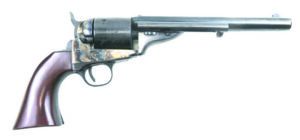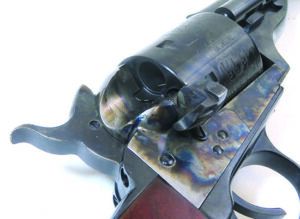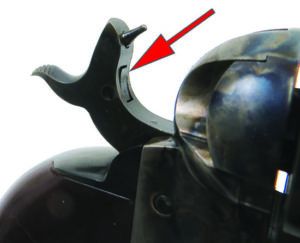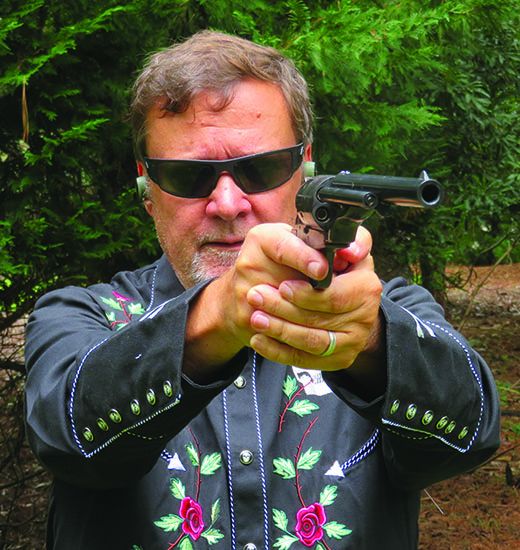In the June 2024 issue, we looked at two reproduction revolvers that allow you to experience what it was like to wield these guns in the Old West, except that the newer models sometimes have improved features and they certainly have improved materials. The first of those wheelguns were new sidearms chambered in 45 Colt, the Cimarron Firearms Co. Model No. 3, 1st Model American, and the Taylor’s & Company Cattleman Old Model Military Markings. We rated the Taylor’s Cattleman as a grade A gun, while the Cimarron earned a grade B nod.
This month, we’ll look at a used Ruger Vaquero in 45 Long Colt, the old model that is no longer produced, and a new Uberti 1872 Open Top Army CA910 in 44 Special. We evaluated these single-action revolvers for accuracy, sight regulation to point of impact, trigger weight, ease of use, and sight quality. These revolvers would do well in Cowboy Action Shooting matches or plinking on a weekend.
We first noticed these reproductions had great balance and manageable recoil, and they required some hammer dexterity to make a long stretch of the thumb to cock them. Sights ranged from too tiny to see well, to large and very modern.
We began accuracy testing using targets set at 15 yards and a range bag as a rest. We then fired the revolvers for speed using both one- and two-hand grips with the targets at 7 yards. Firing at speed shows how well the shooter can manage recoil and how fast you can acquire the sights for follow-up shots.
Naturally, we used some cowboy loads in lower velocities, which offer less recoil. They are also a good option for plinking. In 45 Colt, we fired Hornady Cowboy loads with 255-grain round-nose flat-point (RNFP) bullets and Choice Ammunition with a 250-grain RNFP bullet. Also, we used a more modern Federal American Eagle load with a 225-grain jacketed soft point (JSP). It’s worth noting that of the three 45 Colt revolvers, only the Ruger is compatible with +P ammo.
Once we had a chance to fill our hands with these pistols, here’s what we learned about these reproduction handguns.
Uberti 1872 Open Top Army CA910 44 Special
$538
Gun Tests grade: B
The 1872 Open Top is a transitional revolver that spans percussion and metallic cartridge design. Sights are tiny but usable, recoil is mild, and accuracy was good. Has the longer Colt 1860 Army percussion revolver grip that offers nice handling.

| Action Type | Revolver, single action, hammer fired |
| Overall Length | 12.7 in. |
| Barrel Length | 7.5 in. |
| Barrel Twist Rate | 1:20 in. RH |
| Sight Radius | 6.5 in. |
| Overall Height | 5.5 in. |
| Maximum Width | 1.6 in. |
| Weight Unloaded | 32.7 oz. |
| Weight Loaded | 37.9 oz. |
| Cylinder Gap | 0.08 in. |
| Capacity | 6 |
| Frame Finish | Case hardened |
| Barrel/Cylinder Finish | Blued |
| Frame Front Strap Height | 2.4 in. |
| Frame Back Strap Height | 3.9 in. |
| Grip | Smooth walnut, one piece |
| Grip Thickness (maximum) | 1.5 in. |
| Grip Circumference (maximum) | 6.2 in. |
| Front Sight | Fixed blade |
| Rear Sight | U notch |
| Hammer Cocking Effort | 3.0 lbs. |
| Trigger Pull Weight | 2.2 lbs. |
| Trigger Span | 2.7 in. |
| Safety | None |
| Warranty | 5 years to life |
| Telephone | (800) 264-4962 |
| Website | Uberti-USA.com |
| Made In | Italy |
Colt originally called it the New Model Holster Pistol, but it became referred to as the Model 1871-72 Open Top. Uberti calls it the 1872 Open Top Army. The Model 1871-72 is significant because it was Colt’s first revolver design to specifically use metallic cartridges. Colt had converted Navy and Army percussion revolvers to shoot metallic cartridges, and those are called conversion revolvers, but this was the first revolver built from scratch to employ the then-new metallic cartridge technology and bored-through cylinder. These revolvers employed a straight-sided cylinder and new barrel and frame design. There is the period-correct W.L. Ormsby 1843 Naval scene roll engraved on the cylinder, which is the same engraving used on the 1851 Navy and 1860 Army percussion revolvers. Early models from 1871 used an 1851 Navy grip and models made in 1872 used a grip from an 1860 Army revolver. These revolvers also have the distinction of being chambered in 44 Henry, the same caliber used in Henry and Winchester 1866 rifles, so this revolver was the first to use ammo compatible with a rifle. Consider this a transitional gun because the next model produced by Colt was the iconic Model 1873 SAA revolver.
The Uberti Open Top is a faithful reproduction of the 1872 model with the longer grip from the 1860 Army percussion revolver. The sample tested wore a nice case-hardened finish on the frame and hammer and a deep blue on the barrel, ejector, and grip frame. Smooth walnut grips were fitted well on the back strap, but the wood overlapped the front bottom edge of the front grip strap — an obvious miss on Uberti’s part. It is still a sharp-looking six-shooter. The cylinder is slightly elongated to accommodate the 44 Special cartridge. It is also compatible with 44 Colt and 44 Russian ammo. Locating 44 Colt is difficult and 44 Russian is only marginally easier, but 44 Special is common and less expensive, so our testing employed only 44 Special ammo.

The front sight is a small blade, and the rear sight is an even smaller notch at the back end of the barrel where it meets the cylinder. Tiny sights to say the least, but usable. To load, cock the hammer back half way to open the loading gate. Best practice is to load one, skip one, and load the rest so that the hammer rests on an empty chamber. Uberti built a safety block into the hammer that is engaged via a small screwdriver. You need the screwdriver to turn it back to fire the revolver. This feature is okay to store the revolver, but it is not practical in the field or on the range.
A wedge is used to secure the barrel to the frame like that on Colt’s percussion revolvers, so takedown will require a flat-blade screwdriver and a nylon hammer to disengage the barrel from the frame, especially after extended shooting.
The grip shape and angle are very comfortable. The gun balances just behind the shooting finger. Cocking the hammer takes 3 pounds of effort, and the hammer has three positions: fully forward, half cock, and full cock. The trigger is the traditional skinny Colt SAA-style piece, and it broke at a very crisp 2.2 pounds. Very nice trigger.

The best five-shot group was with Fiocchi, which measured 1.30 inches. HSM Cowboy’s smallest group measured 2.14 inches, and the modern SIG V-Crown had a smallest group that measured 1.73 inches. The revolver shot to point of aim and was pleasant in recoil, curling up in our hands like hoglegs do. The sights were tiny and hard to focus on in accuracy testing, but average-accuracy groups across all ammo measured 1.3 to 2.5 inches, which is mighty good in our book.
Going for speed with low-velocity cowboy ammo, the Uberti shot 2.5-inch groups at 7 yards. It was fast to shoot the Open Top with a two-hand hold and the support hand thumb-cocking the hammer. Or one-handed, we would hold the trigger back and keep thumbing the hammer to rapid-fire the Open Top. The geometry of the hammer requires the user to reach for the spur, which can slow speed shooting.
Most cases fell free from the chambers. Occasionally, we pushed the ejector to dislodge stuck cases. The ejector head rotates away from the barrel so your digits don’t get branded from a hot barrel.
Our Team Said: The 1872 Open Top is a unique item and another revolver to add to your bucket list. This was a fun revolver to shoot, and it offers speed, good accuracy, and pleasant recoil. It is a barking iron that will turn heads at the range.
| 44 SPECIAL RANGE DATA | |
| Fiocchi 210-grain TCFP | Uberti 1872 Open-Top Conversion |
| Average Velocity | 750 fps |
| Muzzle Energy | 262 ft.-lbs. |
| Smallest Group | 1.30 in. |
| Average Group | 1.39 in. |
| SIG V-Crown 200-grain JHP | Uberti 1872 Open-Top Conversion |
| Average Velocity | 700 fps |
| Muzzle Energy | 218 ft.-lbs. |
| Smallest Group | 1.73 in. |
| Average Group | 1.88 in. |
| HSM 200-grain RNFP | Uberti 1872 Open-Top Conversion |
| Average Velocity | 784 fps |
| Muzzle Energy | 273 ft.-lbs. |
| Smallest Group | 2.14 in. |
| Average Group | 2.53 in. |
To collect accuracy data, we fired five-shot groups from a bench using a rest. Distance: 15 yards with open sights. We recorded velocities using a ProChrono DLX digital chronograph set 10 feet from the muzzle.
Special thanks to Eastern Outfitters (EasternOutfitter.com) of Hampstead, NC, for their assistance.
Written and photographed by Robert Sadowski, using evaluations from Gun Tests Team members. GT

























